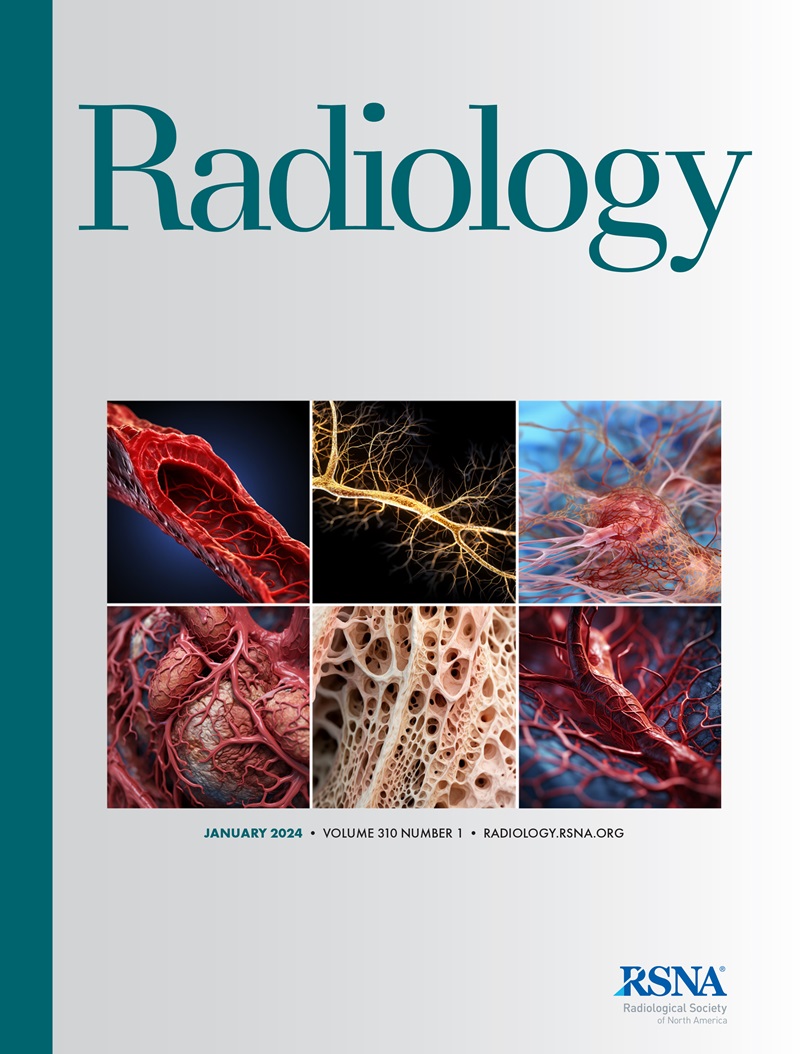求助PDF
{"title":"Breast Cancer Detection with Standalone AI versus Radiologist Interpretation of Unilateral Surveillance Mammography after Mastectomy.","authors":"Su Min Ha, Janie M Lee, Myoung-Jin Jang, Hong-Kyu Kim, Jung Min Chang","doi":"10.1148/radiol.242955","DOIUrl":null,"url":null,"abstract":"<p><p>Background Limited data are available regarding the accuracy of artificial intelligence (AI) algorithms trained on bilateral mammograms for second breast cancer surveillance in patients with a personal history of breast cancer treated with unilateral mastectomy. Purpose To compare the performance of standalone AI for second breast cancer surveillance on unilateral mammograms with that of radiologists reading mammograms without AI assistance. Materials and Methods In this retrospective institutional database study, patients who were diagnosed with breast cancer between January 2001 and December 2018 and underwent postmastectomy surveillance mammography from January 2011 to March 2023 were included. Radiologists' mammogram interpretations without AI assistance were collected from these records and compared with AI interpretations of the same mammograms. The reference standards were histologic examination and 1-year follow-up data. The cancer detection rate per 1000 screening examinations, sensitivity, and specificity of standalone AI and the radiologists' interpretations without AI were compared using the McNemar test. Results Among the 4184 asymptomatic female patients (mean age, 52 years), 111 (2.7%) had contralateral second breast cancer. The cancer detection rate (17.4 per 1000 examinations [73 of 4184]; 95% CI: 13.7, 21.9) and sensitivity (65.8% [73 of 111]; 95% CI: 56.2, 74.5) were greater for standalone AI than for radiologists (14.6 per 1000 examinations [61 of 4184]; 95% CI: 11.2, 18.7; <i>P</i> = .01; 55.0% [61 of 111]; 95% CI: 45.2, 64.4; <i>P</i> = .01). The specificity was lower for standalone AI than for radiologists (91.5% [3725 of 4073]; 95% CI: 90.6, 92.3 vs 98.1% [3996 of 4073]; 95% CI: 97.6, 98.5; <i>P</i> < .001). AI detected 16 of 50 (32%) cancers missed by radiologists; however, 34 of 111 (30.6%) breast cancers were missed by both radiologists and AI. Conclusion Standalone AI for surveillance mammography showed higher sensitivity with lower specificity for contralateral breast cancer detection in patients treated with unilateral mastectomy than radiologists without AI assistance. © RSNA, 2025 <i>Supplemental material is available for this article.</i> See also the editorial by Philpotts in this issue.</p>","PeriodicalId":20896,"journal":{"name":"Radiology","volume":"315 1","pages":"e242955"},"PeriodicalIF":12.1000,"publicationDate":"2025-04-01","publicationTypes":"Journal Article","fieldsOfStudy":null,"isOpenAccess":false,"openAccessPdf":"","citationCount":"0","resultStr":null,"platform":"Semanticscholar","paperid":null,"PeriodicalName":"Radiology","FirstCategoryId":"3","ListUrlMain":"https://doi.org/10.1148/radiol.242955","RegionNum":1,"RegionCategory":"医学","ArticlePicture":[],"TitleCN":null,"AbstractTextCN":null,"PMCID":null,"EPubDate":"","PubModel":"","JCR":"Q1","JCRName":"RADIOLOGY, NUCLEAR MEDICINE & MEDICAL IMAGING","Score":null,"Total":0}
引用次数: 0
引用
批量引用
Abstract
Background Limited data are available regarding the accuracy of artificial intelligence (AI) algorithms trained on bilateral mammograms for second breast cancer surveillance in patients with a personal history of breast cancer treated with unilateral mastectomy. Purpose To compare the performance of standalone AI for second breast cancer surveillance on unilateral mammograms with that of radiologists reading mammograms without AI assistance. Materials and Methods In this retrospective institutional database study, patients who were diagnosed with breast cancer between January 2001 and December 2018 and underwent postmastectomy surveillance mammography from January 2011 to March 2023 were included. Radiologists' mammogram interpretations without AI assistance were collected from these records and compared with AI interpretations of the same mammograms. The reference standards were histologic examination and 1-year follow-up data. The cancer detection rate per 1000 screening examinations, sensitivity, and specificity of standalone AI and the radiologists' interpretations without AI were compared using the McNemar test. Results Among the 4184 asymptomatic female patients (mean age, 52 years), 111 (2.7%) had contralateral second breast cancer. The cancer detection rate (17.4 per 1000 examinations [73 of 4184]; 95% CI: 13.7, 21.9) and sensitivity (65.8% [73 of 111]; 95% CI: 56.2, 74.5) were greater for standalone AI than for radiologists (14.6 per 1000 examinations [61 of 4184]; 95% CI: 11.2, 18.7; P = .01; 55.0% [61 of 111]; 95% CI: 45.2, 64.4; P = .01). The specificity was lower for standalone AI than for radiologists (91.5% [3725 of 4073]; 95% CI: 90.6, 92.3 vs 98.1% [3996 of 4073]; 95% CI: 97.6, 98.5; P < .001). AI detected 16 of 50 (32%) cancers missed by radiologists; however, 34 of 111 (30.6%) breast cancers were missed by both radiologists and AI. Conclusion Standalone AI for surveillance mammography showed higher sensitivity with lower specificity for contralateral breast cancer detection in patients treated with unilateral mastectomy than radiologists without AI assistance. © RSNA, 2025 Supplemental material is available for this article. See also the editorial by Philpotts in this issue.
独立人工智能检测乳腺癌与乳房切除术后单侧监测乳房x光检查的放射科医生解释。
背景:对于有单侧乳房切除术的个人乳腺癌病史的患者,人工智能(AI)算法训练的双侧乳房x光片用于二次乳腺癌监测的准确性数据有限。目的比较独立人工智能在单侧乳房x光片二次乳腺癌监测中的表现与放射科医生在没有人工智能辅助的情况下阅读乳房x光片的表现。在这项回顾性机构数据库研究中,纳入了2001年1月至2018年12月诊断为乳腺癌的患者,并于2011年1月至2023年3月接受了乳房切除术后乳房x光检查。从这些记录中收集放射科医生在没有人工智能帮助下的乳房x光片解读,并与人工智能对相同乳房x光片的解读进行比较。参照标准为组织学检查和1年随访资料。使用McNemar试验比较独立人工智能和放射科医生在没有人工智能的情况下的解释的每1000次筛查的癌症检出率、敏感性和特异性。结果4184例无症状女性患者(平均年龄52岁)中111例(2.7%)发生对侧第二乳腺癌。癌症检出率(17.4 / 1000例[4184例中的73例];95% CI: 13.7, 21.9)和敏感性(65.8% [73 / 111];95% CI: 56.2, 74.5),独立人工智能患者的死亡率高于放射科医生(14.6 / 1000次检查[4184例中的61例];95% ci: 11.2, 18.7;P = 0.01;55.0%[111例中的61例];95% ci: 45.2, 64.4;P = 0.01)。独立人工智能的特异性低于放射科医生(91.5% [3725 / 4073]);95% CI: 90.6, 92.3 vs 98.1% [3996 / 4073];95% ci: 97.6, 98.5;P < 0.001)。人工智能检测出放射科医生遗漏的50种癌症中的16种(32%);然而,111例乳腺癌中有34例(30.6%)被放射科医生和人工智能都遗漏了。结论在单侧乳房切除术患者中,独立人工智能监测乳房x线摄影对对侧乳腺癌的检测灵敏度高于无人工智能辅助的放射科医师,但特异性较低。©RSNA, 2025本文可获得补充材料。参见菲尔波茨在本期的社论。
本文章由计算机程序翻译,如有差异,请以英文原文为准。

 求助内容:
求助内容: 应助结果提醒方式:
应助结果提醒方式:


